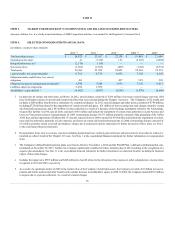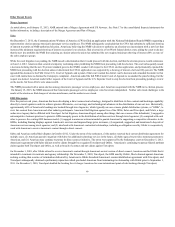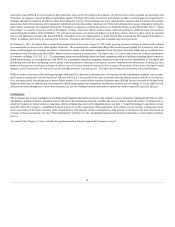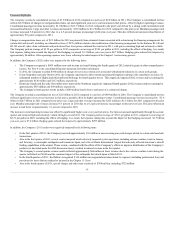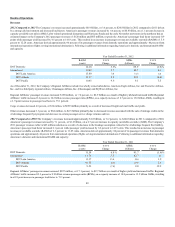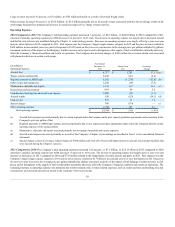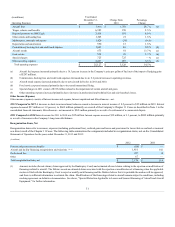American Airlines 2012 Annual Report Download - page 44
Download and view the complete annual report
Please find page 44 of the 2012 American Airlines annual report below. You can navigate through the pages in the report by either clicking on the pages listed below, or by using the keyword search tool below to find specific information within the annual report.
related to the impairment of certain aircraft and gates and a $43 million revenue reduction as a result of a decrease in the breakage assumption related
to the AAdvantage frequent flier liability.
•The Company reduced capacity by approximately 3% in the fourth quarter of 2011 due to the uncertain economic environment, high fuel costs, and
higher than normal pilot retirements. As a result, the Company’s results were adversely impacted by approximately $55 million in the quarter.
The Company recorded a net loss of $469 million in 2010 compared to a net loss of $1.5 billion in 2009. The Company’s smaller net loss in 2010 reflected a
strengthening of the revenue environment in a weak global economy which led to higher passenger revenues, partially offset by higher fuel prices. In addition to
higher fuel expenses, the Company’s 2010 results were negatively impacted by $81 million in special items. The special items consisted of $53 million related
to the Venezuelan currency remeasurement in January 2010 and a $28 million non-cash impairment of certain routes in Latin America.
Liquidity and Capital Resources
The matters described herein, to the extent that they relate to future events or expectations, may be significantly affected by the Chapter 11 Cases. Those
proceedings will involve, or may result in, various restrictions on our activities, limitations on financing, the need to consult with the Creditors' Committee
and other key stakeholders and to obtain Bankruptcy Court approval for various matters and uncertainty as to relationships with vendors, suppliers,
customers, labor and others with whom we may conduct or seek to conduct business. The Debtors cannot predict the impact, if any, that its Chapter 11
Cases might have on these obligations. For further information regarding the Chapter 11 Cases, see Note 1 to the consolidated financial statements.
Cash, Short-Term Investments and Restricted Assets
At December 31, 2012, the Company had $3.9 billion in unrestricted cash and short-term investments and $850 million in restricted cash and short-term
investments, both at fair value, versus $4.0 billion in unrestricted cash and short-term investments and $738 million in restricted cash and short-term
investments at December 31, 2011.
The Company has restricted cash and short-term investments related primarily to collateral held to support projected workers compensation obligations and
funds held for certain tax obligations.
As of December 31, 2012, approximately $527 million of the Company's cash and short-term investments balances were held in foreign bank accounts, of
which $413 million is held in Venezuela. On February 8, 2013, the Venezuelan Government devalued its currency from 4.3 bolivars per U.S. dollar to 6.3
bolivars per U.S. dollar. Subsequently, the Venezuelan Government decreed that for applications of foreign exchange related to international air transportation
operations filed with the Venezuelan Government on or before February 8, 2013, the rate of 4.30 bolivars per U.S. dollar would be applied. As a result, the
Company does not expect to recognize a material loss related to the currency remeasurement in February 2013. The Company does not expect any significant
ongoing impact of the currency devaluation on its operations in Venezuela, but there can be no assurances to that effect. As further discussed in the Risk
Factors included under Item 1A, currency is subject to risks including exchange controls, changes in foreign exchange rates and currency devaluation.
The Company’s unrestricted short-term investment portfolio consists of a variety of what the Company believes are highly liquid, lower risk instruments
including money market funds, government agency investments, repurchase agreements, short-term obligations, corporate obligations, bank notes, certificates
of deposit and time deposits. AMR’s objectives for its investment portfolio are (1) the safety of principal, (2) liquidity maintenance, (3) yield maximization,
and (4) the full investment of all available funds. The Company’s risk management policy further emphasizes superior credit quality (primarily based on
short-term ratings by nationally recognized statistical rating organizations) in selecting and maintaining investments in its portfolio and enforces limits on the
proportion of funds invested with one issuer, one industry, or one type of instrument. The Company regularly assesses the market risks of its portfolio, and
believes that its established policies and business practices adequately limit those risks. As a result, the Company does not anticipate any material adverse
impact from these risks.
Certain of the Company’s debt financing agreements contain loan to value ratio covenants and require the Company to periodically appraise the collateral.
Pursuant to such agreements, if the loan to value ratio exceeds a specified threshold, the Company may be required to subject additional qualifying collateral
(which in some cases may include cash collateral) or, in the alternative, to pay down such financing, in whole or in part, with premium (if any). One of such
agreements also includes covenants that, among other things, limit the ability of the Company and its subsidiaries to merge, consolidate, sell assets, incur
additional indebtedness, issue preferred stock, make investments and pay dividends. In addition, under such agreement, if American fails to maintain a
collateral ratio of 1.5 to 1.0, American must pay additional interest on the related notes (which bear interest at 7.5% per annum) at the rate of 2% per annum
until the collateral coverage ratio equals at least 1.5 to 1.0. See Note 7 to the consolidated financial statements for further information.
Significant Indebtedness and Future Financing
44




